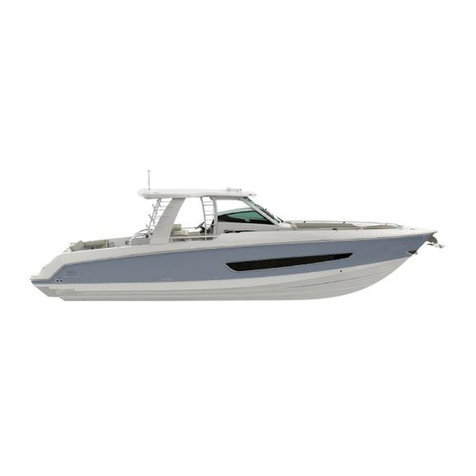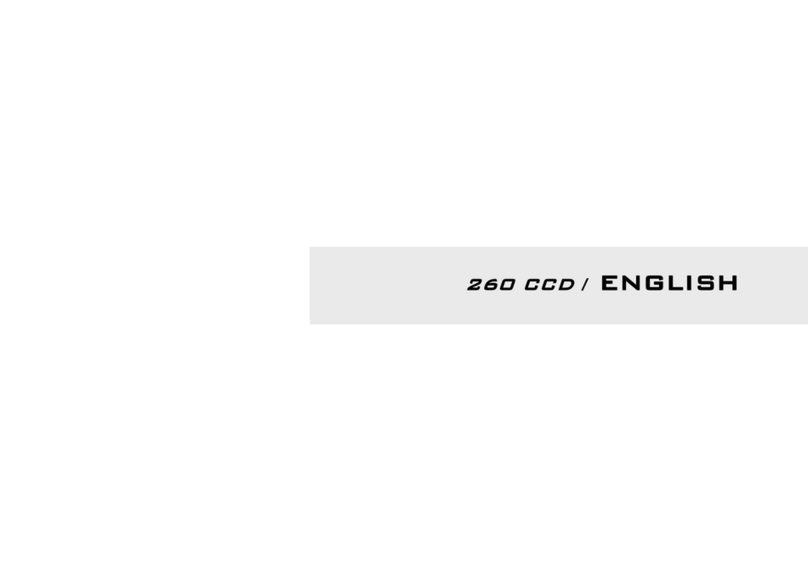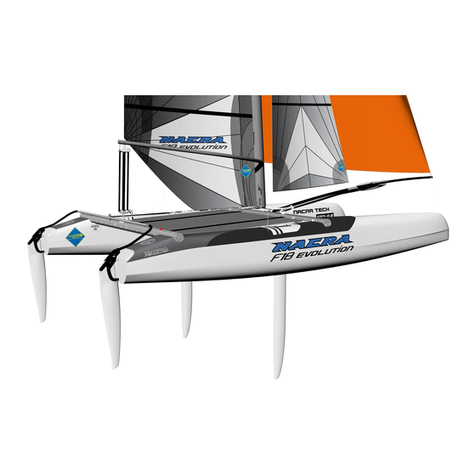Southern Pacific Inflatables PerformR RIB User manual

Owner's Manual PerformR RIB
Victoria Street West
Auckland
1142
New Zealand
IMAGE HERE?
Owner's Manual
'PerformR RIB'
If this is your first craft, or you are changing to a type of craft you are not familiar with, for your own comfort and
safety, ensure that you obtain handling and operating experience before assuming command of the craft. Any
boat dealer or national sailing federation or yacht club will be pleased to advise you of local sea schools, or
competent instructors.
PerformR RIB
Please keep this manual in a secure place and hand it over to
the new owner when you sell the craft.
Technical Software © HPi-CEproof 2021
1/29

Owner's Manual PerformR RIB
Section
1
1.1
1.2
2
2.1
2.2
2.3
3
3.1
3.1.1
3.2
3.2.1
3.2.2
3.2.3
3.2.4
3.2.5
3.2.6
4
4.1
4.2
4.2.1
4.3
4.3
4.4
5
5.1
5.2
5.3
5.4
5.4.1
5.5
5.6
GENERAL ARRANGEMENT
DC System
General Good Practice
Risk of Falling Overboard
Risk of Fire
RCD Design Category Explanation
Grounding - Risks & Actions
CONTENTS
ABOUT THIS MANUAL
Safety Labels
Boating Experience
WELCOME
Responsibility
Explanation of Hazard Warnings
Original Equipment Manufacturer (OEM) Manuals
Risk of Flooding
Boat Identification & CE Marking Classification
Hull Size
SYSTEMS DESCRIPTIONS
Weights
Structural Fittings & Materials
Principal Dimensions
Maximum Recommended Power
Fixed Tanks
PRE-LAUNCH OBSERVATIONS
Bilge pumps
Fuel System
Tubes
Electrical System
Risk of Loss of Stability
Other Fuel Burning Devices
Steering System
Recommended Safety Equipment
Technical Software © HPi-CEproof 2021
2/29

Owner's Manual PerformR RIB
6
6.1
6.2
6.3
6.4
6.5
6.6
7
7.1
7.2
7.3
8
8.1
8.2
8.3
8.4
8.5
8.5.1
8.6
ENVIRONMENTAL AWARENESS
Noise
Visibility from the Main Steering Position
Wash / Waves
Winter Storage
Leakage of Petrochemicals
Use of Engines
Black & Grey Water
Maintaining the Electrical System
Handling Characteristics
Maintenance & Storage of Tubes
Household Waste
Exhaust system
Dangers of Carbon Monoxide
MAINTENANCE
Anchoring, Mooring & Towing
Navigation Lights
NAVIGATION & OPERATION
Filling With Fuel
Technical Software © HPi-CEproof 2021
3/29

Owner's Manual PerformR RIB
1
1.1
1.2
1
2
3
4Keep a sharp lookout for people and objects in the water;
Congratulations on becoming the new owner of a: PerformR RIB
Boating Experience
This manual has been compiled to help you to operate your craft with safety and pleasure. It contains
details of the craft, the equipment supplied or fitted, its systems and information on their operation,
set up, maintenance, prevention of risks and management of those risks. Please read carefully and
familiarize yourself with the craft before using it.
Follow the rules of the road;
WELCOME
This owner's manual is not a course on boating safety or seamanship. If this is your first craft, or if
you are changing to a type of craft you are not familiar with, for your own comfort and safety, please
ensure that you obtain handling and operating experience before “assuming command” of the craft.
It is the boat owner/operator's responsibility to:
Always use trained and competent people for maintenance, repair or modifications. Modifications that
may affect the safety characteristics of the craft shall be assessed, executed and documented by
competent people. The boat builder cannot be held responsible for modifications that boat builder has
not approved.
Responsibility
In some countries, a driving licence or authorization is required, or specific regulations are in force
and carriage requirements may be subject to local regulations.
Ensure that the anticipated wind and sea conditions will correspond to the design
category of your boat and that you and your crew are able to handle the boat in
these conditions;
Know the limitations of your boat;
Any boat dealer or national sailing federation or yacht club will be pleased to advise you of local sea
schools, or competent instructors.
This owner's manual is not a detailed maintenance or trouble-shooting guide. In the case of difficulty,
refer to the boat builder or boat builder's representative. If a maintenance manual is provided, use it
for the craft's maintenance.
Even when your boat is categorized for them, the sea and wind conditions corresponding to the
design categories A, B and C range from severe gale conditions for category A, to strong conditions
for the top of category C, open to the hazards of a freak wave or gust. These are therefore dangerous
conditions, where only a competent, fit and trained crew using a well-maintained craft can
satisfactorily operate.
Technical Software © HPi-CEproof 2021
4/29

Owner's Manual PerformR RIB
5
6
7
8
2
2.1
A list of these manuals is given here:
Original Equipment Manufacturer (OEM) Manuals
This manual includes important fundamentals regarding equipment supplied by other manufacturers.
More detailed information regarding such equipment can be found in manuals provided by the OEM.
Steering gear
Batteries
This
manual
has
been
compiled
to
help
you
to
operate
your
craft
with
safety
and
pleasure.
It
contains
details of the craft; the equipment supplied or fitted its systems and information on their operation.
Please read it carefully and familiarise yourself with the craft before using it. Ensure that everyone
who will operate the vessel reads this manual before setting out.
This manual complies with the EU Recreational Craft Directive (RCD) and should not be perceived as
an exhaustive guide to the vessel. A manual is not a replacement for experience and common
sense!
Reduce speed when there is limited visibility, rough water, people in the water
nearby, boats, or structures;
Engine
Any craft, no matter how strong it may be, can be severely damaged if not used properly. Inspect the
craft regularly especially after any kind of suspected damage. Always adjust the speed and direction
of the craft to sea conditions.
Navigation lights
Be aware of the crew/passenger's safety at all times;
Never sail when the operator is under the influence of drugs or alcohol;
All persons should wear a suitable personal floatation device (life jacket/ buoyancy aid) when on
deck. Note that, in some countries, it is a legal requirement to wear a personal floatation device that
complies with their national regulations.
ABOUT THIS MANUAL
If your craft is fitted with a liferaft, carefully read its operating manual. The craft should have onboard
the appropriate safety equipment (lifejackets, harnesses, etc.) according to the type of craft, weather
conditions, etc. This equipment is mandatory in some countries. The crew should be familiar with the
use of all safety equipment and emergency manoeuvring (man overboard recovery, towing, etc.).
Sailing schools and clubs regularly organize training sessions.
Always maintain your craft properly and take into account the deterioration that will
occur over time and as a result of heavy use or misuse of the craft.
Technical Software © HPi-CEproof 2021
5/29

Owner's Manual PerformR RIB
2.2
2.3
Sling position for safe lifting of
the vessel
indicates a potentially hazardous situation that, if not avoided, could
result in minor or moderate injury.
Warning
Dedicated discharge opening
for extinguisher
FIRE
PORT
Location of fire extinguisher
Danger
indicates a potentially hazardous situation that, if not avoided, could
result in minor or moderate injury.
indicates information considered important, but not hazard-related, for
example, relating to property damage.
Explanation of Hazard Warnings
Do not remove or obstruct any safety label. Replace any label which
becomes illegible.
Caution
Safety Labels
The craft and this manual show symbols which advise the owner/operator and crew of imperative
safety precautions to follow when operating and/or servicing equipment. The following symbols may
be found on your craft. They should be respected at all times.
Electrical Hazard Fuel fill point: letter 'D denotes
suitability for 'diesel fuel
Read the Owners Manual
Hazard - usually followed by text
description (see following
section)
Fire Hazard
indicates a potentially hazardous situation that, if not avoided, could
result in death or serious injury.
Caution
Notice
Technical Software © HPi-CEproof 2021
6/29

Owner's Manual PerformR RIB
3
3.1
lear BCD
adults
6
1 RCD = EU Recreational Craft Directive (2013/53/EU)
2 See table in section
3 For maximum weight limit see: 3.2.3
3.1.1
RCD Design Category Explanation
Warning
Do not exceed the maximum recommended number of persons.
Regardless of the number of persons on board, the total mass of
persons and equipment must never exceed the maximum recommended
load. Always use the seats/occupancy areas provided.
This vessel carries the CE marking (shown here) to indicate that it complies with
the EU Recreational Craft Directive. It has been assigned the Design Category
explained below:
RCD Design Category
Kiwi Yachting Consultants T/A Southern
Pacific Inflatables
Manufacturer's Craft Identification Number NZ-QFX00000C121
Type of Boat
Picture of boat/layout
GENERAL ARRANGEMENT
Name of Boat Manufacturer
A watercraft given design category C is considered to be designed to operate in typical steady winds
of Beaufort force 6 or less and the associated significant waves heights of up to 2 m. Typically such
conditions might be encountered on exposed inland waters, in estuaries, and in coastal waters in
moderate weather conditions. Depending on atmospheric conditions, winds can gust to about 18 m/s.
Boat Identification & CE Marking Classification
PerformR RIB
Maximum recommended number of people
Technical Software © HPi-CEproof 2021
7/29

Owner's Manual PerformR RIB
3.2
3.2.1 Hull Size
LH
(m)
LWL
(m)
LMAX
(m)
BH
(m)
BWL
(m)
BMAX
(m)
β(deg)
F
F
(m)
F
M
(m)
F
A
(m)
T (m)
H
A
(m)
3.2.2
100 (hp) (metric)
74 (kW)
3.2.3
18
450
50
m
MBP
500
59
59
m
ML
556
m
EC
295
m
LC
335
m
LDC
1056
The boat in the 'empty craft condition' has a mass of
Max Load as on Builder's Plate
Weight of fluids in fixed tanks
Unladen weight (lightcraft) without engine
1.258
A 'maximum load' has been used for assessing stability and buoyancy, comprising:
Maximum Recommended Load (ISO 14946)
Air draft: max.
1.700
Freeboard amidships
Beam on waterline
Freeboard aft
Freeboard forward
0.730
30.000
Weight Fully Laden
Baggage & other carry on weights
Maximum Number of Persons
Essential safety equipment & liferaft
Maximum capacity of fixed fuel tanks
6.000
All weights in kilograms (kg)
Weights
Beam - maximum
0.470
Maximum draft
Principal Dimensions
1.520
Length on waterline 6.000
Beam of hull
Deadrise Angle 2.180
Kilowatts
Horsepower
Maximum Recommended Power
Power measurement to EN ISO 8665 Marine propulsion engines and systems - Power measurements
and declarations
0.534
Length - max. overall 4.620
Length of Hull
2.180
Technical Software © HPi-CEproof 2021
8/29

Owner's Manual PerformR RIB
1 2
3
4 5
8
=
kg
9
=
kW
10
=
kPa
12
13
1
2
3
4
5
6
7
8
9
10
11
12
13
EN ISO 6185-3
CITY, COUNTRY
MODEL NAME
MAXIMUM
74
1234
Notified body’s identification number (if applicable)
Contact address
Manufacturer’s name, registered trade name or registered trademark
Part of the information is given on the builder's plate affixed on the craft. A full explanation of this
information is also given in the relevant sections of this manual.
MANUFACTURER
ISO classification of inflatable boat
Heaviest allowable outboard motor (kg)
Reference sail area (m²)
Max Load as on Builder's Plate (kg)
Maximum recommended number of people
Maximum Recommended Power (kW)
Tubes: Working pressure: (kPa)
22.0
CE marking
Model name
C
165
Type VII
RCD Design Category
Technical Software © HPi-CEproof 2021
9/29

Owner's Manual PerformR RIB
3.2.4
3.2.5
3.2.6 Structural Fittings & Materials
Specification:
Caution
Warning
Rudders should be inspected regularly for damage and to ensure good
operation.
Attention is drawn to the completion process whereby structural items, for
example steering consoles, seats and superstructures, are installed by
parties other than the manufacturer of the boat. These items should be
installed to comply with the relevant clauses of ISO 6185-4 so it can be
ensured that any such installations do not invalidate the original
assessment.
Tubes
80Petrol fuel tank Port side fwd
Drain Location
Fixed Tanks
Filler LocationFuel Tanks Tank Location Max.
Capacity (L)
No drainUnder Cockpit Floor
POLYMAR® NAUTICA | Boat Line -450g/m²-EN ISO 2286-2 -Resistance to oil and fuel,
dirt repellence -Tear strength (warp/weft) 400/400 N
Technical Software © HPi-CEproof 2021
10/29

Owner's Manual PerformR RIB
4
4.1
4.2
ALWAYS…… •
•
NEVER…….. •
•
•
•
•
Warning
Only fit ignition protected, marine parts to replace such items as starters,
distributors, alternators, generators, etc.
Protective terminal covers, such as rubber boots on electrical
connections, must be in place at all times except when servicing
equipment.
Danger
Petrol vapour can explode.
Warning
Do not use jump leads in the petrol engine/tank space or carry out any
activity that could create sparks.
Warning
Alter or modify the rated current amperage of overcurrent protective devices;
Never use flammable solvents (i.e. kerosene) for bilge cleaning, however
oily it becomes.
Electrical System
Install or replace electrical appliances or devices with components exceeding the
rated current amperage of the circuit;
Check battery and charging system condition before going to sea
Modify the craft's electrical system or relevant drawings: installation, alterations
and maintenance should be performed by a competent marine electrical
technician;
Disconnect and remove the battery when the craft is in winter storage (cold
weather areas) or long term storage
Work on the electrical installation while the system is energised;
Warning The combined capacity of the system is not intended to drain the craft in
the case of damage.
Leave the craft unattended with the electrical system energised, except automatic
bilge-pump, fire protection and alarm circuits.
This boat is not fitted with any bilge pumps.Notice
Bilge pumps
It is recommended that a bailer/bucket is carried aboard for emergency bailing
purposes. Ensure the bucket is protected against accidental loss.
SYSTEMS DESCRIPTIONS
Technical Software © HPi-CEproof 2021
11/29

Owner's Manual PerformR RIB
4.2.1
Voltage
12
12 V DC System
Notice
1
2
3
DC Fuses
The amperage rating is marked on each fuse.
When charging and (dis)connecting a battery ensure that no water or
metal objects can contact the terminals.
Replace fuses with one of the same amperage rating as the original. A
higher rating will render the circuit unprotected against overcurrent.
Turn off all items drawing power from the battery.
Battery Location
Refer to the wiring diagrams at the back of the manual for further details.
Fuse
Description
Nav. Lights
10
Location of Fuses:
Removal of Batteries
Ensure that the battery space is well ventilated at all times.
DC fuses are provided in the various circuits as shown in the following table:
GPS
Main DC Panel Board Location:
5
85Ah
Circuit
Fuse
Fuse
Protection
5
Rating (A)
The battery selector switch is located at: Near Battery
Helm Dashboard
Next to battery
The DC system consists of the following circuits:
Under seat
Rating
The direct current (DC) electrical system derives its power from the series of batteries listed below.
The batteries supply the components listed in tables below which show the settings of the overload
protection breakers/fuses.
Starter battery
Disconnect Switch
DC System
Battery Bank
Caution
Turn the battery switch to the OFF position
Remove the negative cable first, then the positive cable. To replace the cables,
first replace the positive cable, then the negative.
Caution
Caution
Helm Dashboard
To remove the battery cables:
Bilge pump
Technical Software © HPi-CEproof 2021
12/29

Owner's Manual PerformR RIB
1.
2.
3.
4.
5.
6.
7.
8.
9.
4.3
Number
1
Fuel System
The fluid level must be between the lower and upper markings.
Batteries should be disconnected when not in use and especially while
the boat is unattended.
Disconnect switch location(s): Near Battery
Battery Disconnection
Check the fluid levels in the cells (if appropriate for the battery type) approximately
every 4 weeks, and weekly in summer and hot zones.
Replenish only with distilled water. Do not use metal funnel.
The life of some battery types is shortened if drained to zero charge. It is
recommended that a battery not be discharged more than 50 percent. If the
battery does become run down, recharge it as soon as possible.
Coat battery terminal clamps with silicone grease.
Essential service such as electric bilge pumps are wired directly to the
batteries and will run even if the battery disconnect switch is open.
Item
The craft has:
Location
Permanently installed
The following components are supplied by the fuel system:
OutboardEngine
Petrol fuel system
Keep batteries clean and dry.
If your boat will not be used for several weeks remove the batteries from the boat
and connect them to a charger.
If you need to charge a battery, use only a battery charger designed to charge
automotive/marine batteries. Use charger only when batteries are disconnected
from the boat's electrical circuit. Follow the charger instructions.
Battery Maintenance
Caution
Notice
Do not disconnect all batteries while the engine is running; alternator and
wiring damage could occur.
Running the engine to recharge the battery may not be effective. The alternator
only creates charging power at higher engine speeds, idling for long periods will
not generate enough power to recharge the battery.
See table of batteries on previous page.
Battery selector switch location:
Technical Software © HPi-CEproof 2021
13/29

Owner's Manual PerformR RIB
4.4
Mechanism:
All components that burn fuel require an air supply. Ensure all air intakes
are clear before fuel burning components are running.
Steering System
The craft is fitted with the following steering position(s):
Steering Hardware:
Hydraulic
Warning
Caution
Failure of the steering system will cause loss of control of your boat. Any
change in steering such as looseness, tightness, binding, etc., must be
checked immediately by a qualified person.
Helm console
Drive unit
Wheel
Caution
For details on tanks, refer to section: 3.2.4
Warning Do not smoke or use open flame when filling with fuel, when working on
the fuel system and when in the engine room.
Warning
Caution
Petrol generators and outboard motors can produce dangerously high
levels of carbon monoxide, but don’t forget, diesel engine exhaust fumes
have also been linked to illness and deaths.
See section 8.5.1
Warning Inspect fuel lines at least annually. Replace if deterioration or openings
are found.
Danger Never use a flame to check for leaks
If leakage is detected, have the system repaired before further use.
System repairs should be made by a competent person.
Refer to manufacturer's instructions for details of the above equipment.
Caution
Notice The boat's steering system has the following components:
All components of the steering system must undergo periodic inspection
& maintenance to ensure safe operating conditions. Refer to the
maintenance section of this manual for further details.
A kill-chord is provided at the helm so that the engine will cut-out when
pulled. The helmsman should connect him/herself to the kill-chord when
the engine is running.
Turning device:
Refer to the system manufacturer's documentation for information
pertaining to the steering gear.
Danger
Technical Software © HPi-CEproof 2021
14/29

Owner's Manual PerformR RIB
4.5
5
5.1
1
2
3
4
5
6
7
8
9
10
11
12
13
Throttle lever
LocationDescription
The hydraulic system can be powered by the following sources:
Engine trim ram Within drive unit
Drinking water
First aid kit including compress and thermal blanket
The sea can be unpredictable. Be prepared by carrying the following
equipment, as a minimum, at all times.
PRE-LAUNCH OBSERVATIONS
Transom
Hydraulic System
Component
Steering (see section 4.4).
The craft is fitted with the following hydraulic systems:
Rocker switch
Appropriate weatherproof clothing
Recommended Safety Equipment
Anchor and line
Caution
Compass
Distress flares
Bucket
At least 2 warps - see section 6.5
Engine trim
BreakersOutboard engine
Power Source
Controls
N/A
Control LocationLocation
Knife in protective sheath
Binoculars
VHF radio
Charts
Life jacket or buoyancy aid for each person
Supplied off engine harness
Technical Software © HPi-CEproof 2021
15/29

Owner's Manual PerformR RIB
5.2
5.3
1.
Breaking waves are a serious stability hazard
The stability of this boat is significantly reduced at speeds above
displacement speed.
Caution
Risk of Flooding
Caution
Caution
Caution
The stability of the boat is further reduced when bringing your catch on
board if you handle fishing rods or nets outboard.
Loose equipment can cause damage to the craft and affect stability.
Ensure all loose equipment is properly stowed before setting out.
The following openings are marked "WATERTIGHT OPENING - KEEP
SHUT WHEN UNDER WAY" and care should be taken to observe this
warning:
Caution In rough weather, hatches, lockers and companionway/doorways should
be closed to minimise the risk of water ingress.
Ensure all limber holes are clear
Caution
Warning
When loading the craft, never exceed the maximum recommended load.
Always load the craft carefully and distribute loads appropriately to
maintain design trim (approximately level). Avoid placing heavy weights
high up.
The stability and buoyancy of this boat has been assessed on the basis of the weights specified in
section: 3.2.3
Any change in the disposition of the masses aboard (for example, the
addition of a fishing tower, a radar, a stowing mast, change of engine,
etc.) may significantly affect the stability, trim and performance of the
craft
Stability can also be adversely affected by sloshing fluid. Bilge water
should be kept to a minimum
Stability may be reduced when towing or lifting heavy weights using a
davit or boom.
Warning
Caution
Cockpit floor access hatch
Notice
Caution
Risk of Loss of Stability
Technical Software © HPi-CEproof 2021
16/29

Owner's Manual PerformR RIB
5.4
•
•
•
•
•
•
5.4.1 General Good Practice
5.5
3.2.3
5.2
Warning
Never block ventilation
Caution Never store petrol in an area not designed to store petrol
Within cockpit area only
Notice
Notice
The working deck is the area of the boat that is safe for use at all times.
Areas outside the specified working deck should only be used whilst
leaving or arriving at a mooring or whilst the boat is not underway.
For crew area limits, see section:
Caution
use gas lights in craft
On this boat, the working deck area is defined as:
For maximum weight limit see:
Risk of Falling Overboard
Most slips and falls occur during boarding and disembarking. Be aware
that wet decks can be slippery. Wear slip resistant footwear at all times.
Fuel-burning open-flame appliances consume cabin oxygen and release
products of combustion into the craft. Ventilation is required when
appliances are in use. Open designated vent openings while appliances
are in use. Never obstruct ventilation openings and ensure that flued
appliances are operating correctly.
Caution
smoke while handling fuel or gas
obstruct safety controls (shut off valves, switches)
modify craft's systems, especially fuel.
fill any fuel tank whilst machinery is running
obstruct portable extinguishers in lockers
NEVER
Always keep the bilges clean and check for fuel regularly
Risk of Fire
Warning
Technical Software © HPi-CEproof 2021
17/29

Owner's Manual PerformR RIB
5.6
6
6.1
•
•
•
Propeller
Warning
Danger
Notice
The craft is fitted with the following motive power:
4 stroke spark-ignition
Danger
Suzuki DF60ATL Outboard engine
part of outboard engine
Before starting the engine:
Avoid placing flammable materials on or near hot parts.
So as to avoid high-speed moving parts, never run a motor with the cover
removed.
If a fuel leak or fumes are detected, do not start the engine. Ensure all
crew leave the boat and have a qualified person repair the fault as soon
as possible.
Engine
NAVIGATION & OPERATION
Use of Engines
Warning
Take care not to damage fuel lines and check regularly that they are in
good condition
Ensure that any repairs to the inner hull matrix, keel and hull shell are undertaken by a professional
repair yard after consultation with the vessel’s manufacturer or designer and a repair specification
should be developed by either a surveyor, naval architect, or the original yacht manufacturer.
The easiest way to undertake this is to follow the manufacturer’s approved maintenance programme
and approved repair facility instructions.
Caution
After starting the engine, ensure the flow of cooling water
Caution
Grounding - Risks & Actions
After any grounding incident, make a visual inspection internally and
consider a haul out and external inspection as soon as practical.
Controls installed with the motor must have a start-in-gear protection
device. It is the owner's responsibility to ensure this is so, should the
engine or its controls be repaired/replaced.
Ensure that any grounding is discussed with an experienced marine professional to determine
whether a survey of the area and any repair actions are required.
Ensure there is sufficient fuel for the anticipated journey - including a
margin for contingencies.
Check the bilge water level.
Ensure that ventilation openings and ducts are clear to prevent
overheating
Technical Software © HPi-CEproof 2021
18/29

Owner's Manual PerformR RIB
6.2
74 kW 100 hp
31 knots 56 km/h
Ensure all crew are informed about the craft's behaviour.
Before conducting any rapid acceleration or high-speed manoeuvres,
passengers must be warned to sit and hold-on.
This craft is primarily intended to be supported by a combination of
buoyancy and planing forces
Notice
Notice
Notice
Periodic inspection of the propeller for excessive wear or damage is
recommended in order to maintain peak performance and to maximise
the longevity of the engine.
Caution
Seaways are infinitely variable and all craft can meet conditions that will
challenge the boats handling characteristics and/or the helmsman's
ability. Proceed with a margin for error at all times. Avoid making sharp
turns at speed, particularly in a short seaway.
Do not operate this craft at negative propulsion unit trim settings (bow
down) at high speed: the craft may lean over on its side resulting in
instability in turns. Use negative trim to accelerate from displacement to
planing speed and reduce speed in choppy water.
This craft may be entirely clear of the water for short periods of time in
normal operation (i.e. become airborne)
Maximum speed:
Notice
Notice
Warning
Caution
The helmsman may have to take sharp avoiding action at any time.
Passengers should, therefore, be seated and holding-on when underway.
Always use the engine cut-off lanyard.
Handling Characteristics
Notice
Maximum engine power:
Notice
Warning
Caution
It is strongly recommended that helmsmen receive adequate training in
boat handling before setting to sea for the first time.
Caution The owner is responsible for ensuring that normal mode of operation is
maintained. This means that the speed of the craft needs to be matched
to the prevailing sea state and good seamanship shall be displayed.
Technical Software © HPi-CEproof 2021
19/29

Owner's Manual PerformR RIB
Be aware that factors such as altitude, temperature, load, and bottom
growth may affect performance.
Caution
Caution Do not to install engine(s) with power output higher than recommended
by the manufacturer as this could cause loss of craft control and result in
serious injury or death.
Technical Software © HPi-CEproof 2021
20/29
Table of contents
Popular Boat manuals by other brands

Nautiraid
Nautiraid RAID 325 Instruction book

Bayliner
Bayliner DX2000 owner's manual
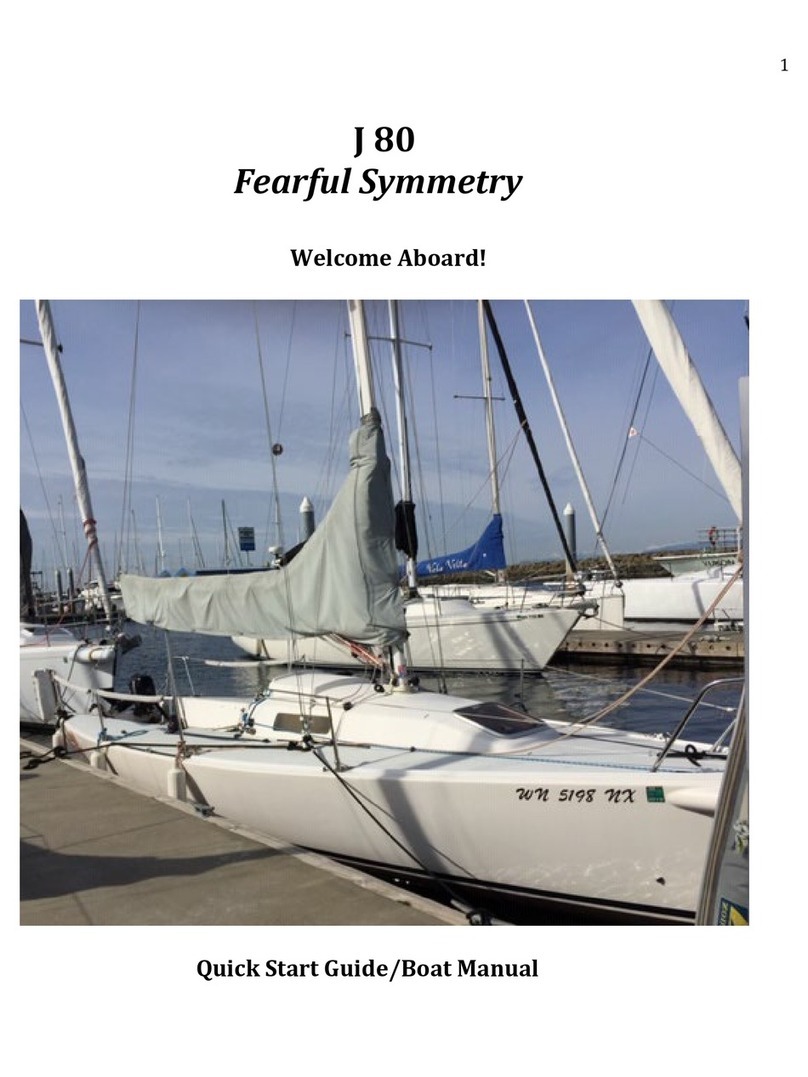
SEATTLE Sailing Club
SEATTLE Sailing Club Fearful Symmetry J 80 quick start guide
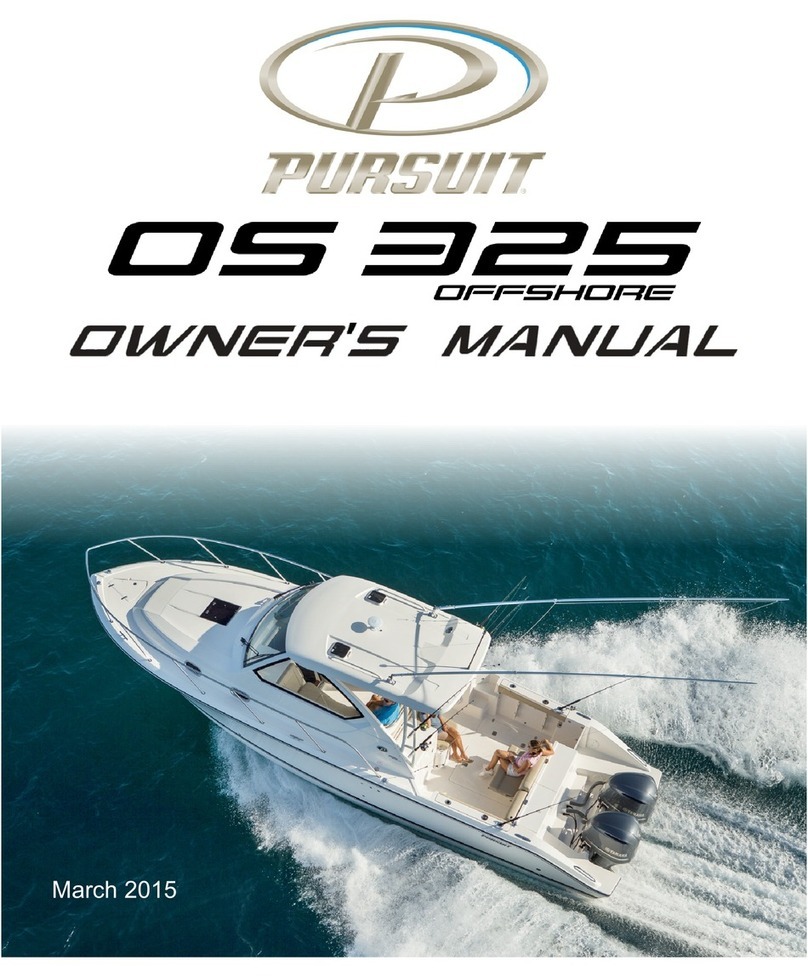
PURSUIT
PURSUIT OS 325 OFFSHORE owner's manual
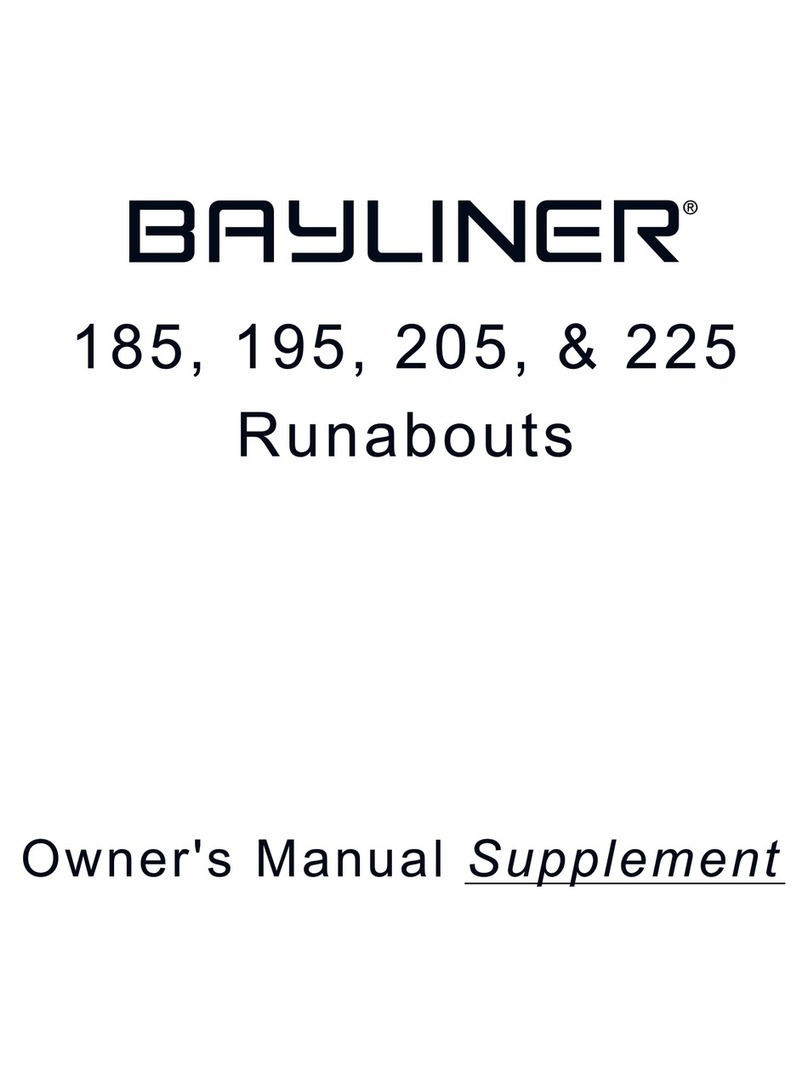
Bayliner
Bayliner 185 owner's manual
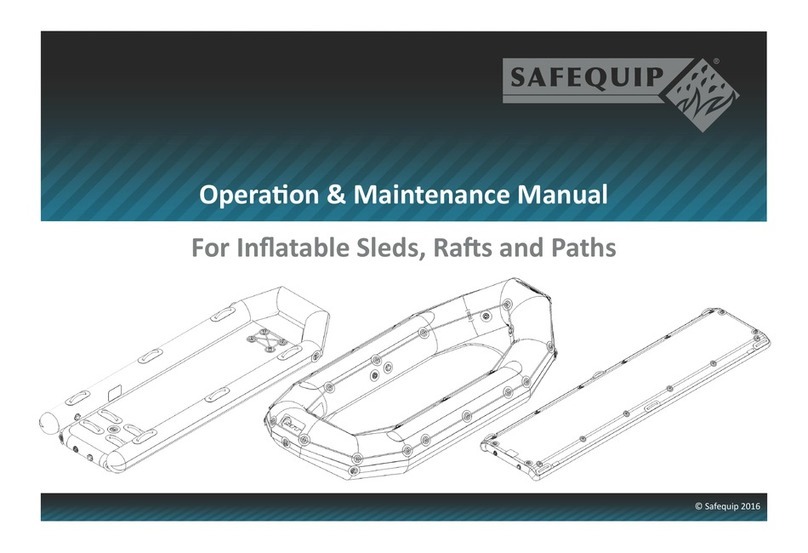
SAFEQUIP
SAFEQUIP Inflatable Sleds Operation & maintenance manual
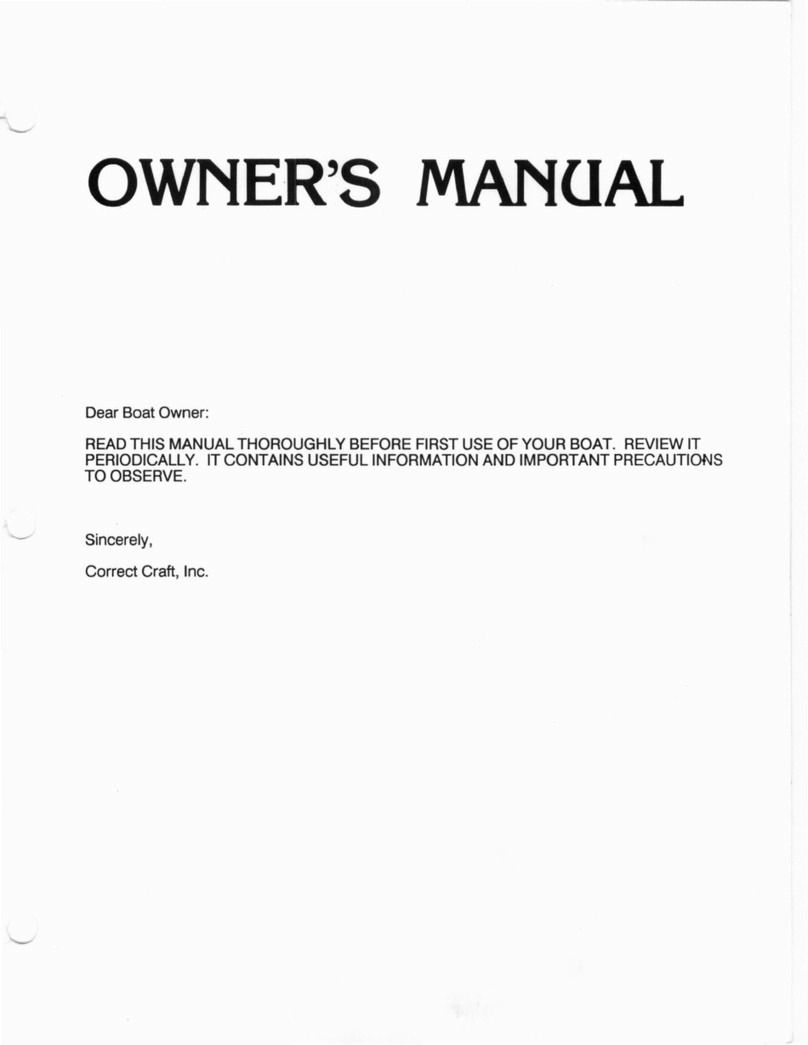
CORRECT CRAFT
CORRECT CRAFT Boat owner's manual
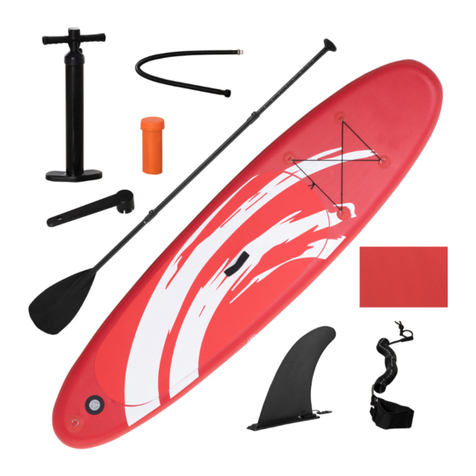
Outsunny
Outsunny A33-028RD owner's manual

UIM
UIM 2013 P750 user guide

Oru Kayak
Oru Kayak BAY ST Assembly guide
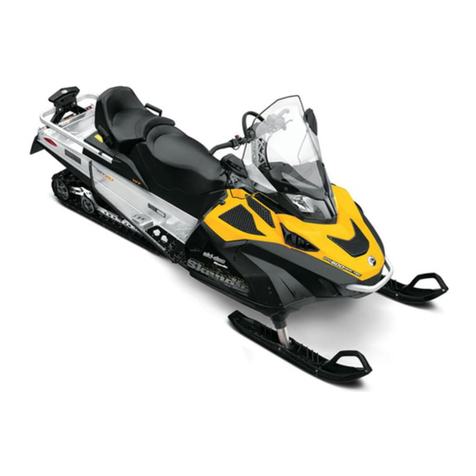
Ski-Doo
Ski-Doo Skandic Series 2016 Operator's guide

Anacortes Yacht Charters
Anacortes Yacht Charters Meg Ann lll 1998 5788 Bayliner operating manual

